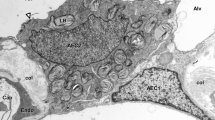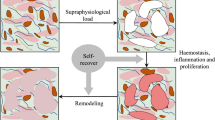Abstract
The steady-state composition of articular cartilage has previously been described as a balance between the metabolism of matrix molecules and the loss of these components from the tissue. Single compartment kinetic models have previously been developed to describe the relationship between these processes and overall (spatially-averaged) concentration of matrix molecules. Here, we develop a continuum model to describe the relationship between spatially-varying matrix concentrations and the processes of matrix formation, binding, degradation, and molecular transport within and from the cartilage tissue. At steady-state, the resultant concentration profile, and also spatially-averaged concentration, are predicted to depend on the balance between diffusivity and binding rate, diffusivity and formation rate, and various rate processes, some of which depend on tissue thickness. The predicted concentration profile, for certain parameter values, exhibits similarities to that known to exist for the proteoglycan matrix component, suggesting that transport factors may play an important role in causing the spatial variation in this component. Under other conditions, the predicted concentration profile may have a large portion of bound components and be relatively constant, consistent with the known distribution of collagen in cartilage. Thus, the continuum model may provide insight into the biophysical mechanism underlying matrix distribution within different regions of articular cartilage.
Similar content being viewed by others
References
Allhands, R. V., Torzilli, P. A. and Kallfelz, F. A.: 1984, Measurement of diffusion of uncharged molecules in articular cartilage, Cornell Vet. 74, 111–123.
Arner, E. C., Pratta, M. A., Trzaskos, J. M. et al.: 1999, Generation and characterization of aggrecanase. A soluble, cartilage-derived aggrecan-degrading activity, J. Biol. Chem. 274, 6594–6601.
Bhakta, N. R., Garcia, A. M., Frank, E. H. et al.: 2000, The insulin-like growth factors (IGFs) I and II bind to articular cartilage via the IGF-binding proteins, J. Biol. Chem. 275, 5860–5866.
Bolis, S., Handley, C. J. and Comper, W. D.: 1989, Passive loss of proteoglycan from articular cartilage explants, Biochim. Biophys. Acta 993, 157–167.
Buckwalter, J. A. and Mankin, H. J.: 1997a, Articular cartilage. Part I: tissue design and chondrocytematrix interactions, J. Bone Joint Surg. 79-A, 600–611.
Buckwalter, J. A. and Mankin, H. J.: 1997b, Articular cartilage. Part II: degeneration and osteoarthrosis, repair, regeneration, and transplantation, J. Bone Joint Surg. 79-A, 612–632.
Campbell, M. A., Handley, C. J., Hascall, V. C. et al.: 1984, Turnover of proteoglycans in cultures of bovine articular cartilage, Arch. Biochem. Biophys. 234, 275–289.
Caterson, B., Flannery, C. R., Hughes, C. E. et al.: 2000, Mechanisms involved in cartilage proteoglycan catabolism, Matrix Biol. 19, 333–344.
Chen, A. C., Bae, W. C., Schinagl, R. M. et al.: 2001, Depth-and strain-dependent mechanical and electromechanical properties of full-thickness articular cartilage, J. Biomech. 34, 1–12.
Comper, W. D. and Williams, R. P.: 1987, Hydrodynamics of concentrated proteoglycan solutions, J. Biol. Chem. 262, 13464–13471.
Eisenberg, S. R. and Grodzinsky, A. J.: 1988, Electrokinetic micromodel of extracellular matrix and other polyelectrolyte networks, Physicochem. Hydrodyn. 10, 517–539.
Fosang, A. J., Last, K., Knauper, V. et al.: 1996, Degradation of cartilage aggrecan by collagenase-3 (MMP-13), FEBS Lett. 380, 17–20.
Fosang, A. J., Last, K., Knauper, V. et al.: 1993, Fibroblast and neutrophil collagenases cleave at two sites in the cartilage aggrecan interglobular domain, Biochem. J. 295, 273–276.
Furuto, D. K. and Miller, E. J.: 1987, Isolation and characterization of collagens and procollagens, Meth. Enzymol. 144, 41–139.
Garcia, A. M., Black, A. C. and Gray, M. L.: 1994, Effects of physicochemical factors on the growth of mandibular condyles in vitro, Calcif. Tissue Int. 54, 499–504.
Garcia, A. M. and Gray, M. L.: 1995, Dimensional growth and extracellular matrix accumulation by neonatal rat mandibular condyles in long-term culture, J. Orthop. Res. 13, 208–219.
Garcia, A. M., Lark, M. W., Trippel, S. B. et al.: 1998, Transport of tissue inhibitor of metalloproteinases-1 through cartilage: contributions of fluid flow and electrical migration, J. Orthop. Res. 16, 734–742.
Hascall, V. C., Handley, C. J., McQuillan, D. J. et al.: 1983a, The effect of serum on biosynthesis of proteoglycans by bovine articular cartilage in culture, Arch. Biochem. Biophys. 224, 206–223.
Hascall, V. C., Luyten, F. P., Plaas, A.H. K. et al.: 1990, Steady-state metabolism of proteoglycans in bovine articular cartilage, In: A. Maroudas and K. Kuettner (eds), Methods in Cartilage Research, Academic Press, San Diego, pp. 108–112.
Hascall, V. C., Morales, T. I., Hascall, G. K. et al.: 1983b, Biosynthesis and turnover of proteoglycans in organ culture of bovine articular cartilage, J. Rheumatol. 10S, 45–52.
Kahn, A., Pottenger, L. A., Albertini, J. G. et al.: 1994, Chemical stabilization of cartilage matrix, J. Surg. Res. 56, 302–308.
Katz, E. P. and Li, S. T.: 1973, The intermolecular space of reconstituted collagen fibrils, J. Mol. Biol. 73, 351–369.
Kimura, J. H., Hardingham, T. E. and Hascall, V. C.: 1980, Assembly of newly synthesized proteoglycan and link protein into aggregates in cultures of chondrosarcoma chondrocytes, J. Biol. Chem. 255, 7134–7143.
Kimura, J. H., Hardingham, T. E., Hascall, V. C. et al.: 1979, Biosynthesis of proteoglycans and their assembly into aggregates in cultures of chondrocytes from the swarm rat chondrosarcoma, J. Biol. Chem. 254, 2600–2609.
Lai, W. M., Hou, J. S. and Mow, V. C.: 1991, A triphasic theory for the swelling and deformation behaviors of articular cartilage, J. Biomech. Engng 113, 245–258.
Lai, W. M., Mow, V. C. and Roth, V.: 1981, Effects of nonlinear strain-dependent permeability and rate of compression on the stress behavior of articular cartilage, J. Biomech. Engng 103, 61–66.
Mak, A. F.: 1986, Unconfined compression of hydrated viscoelastic tissues: a biphasic poroviscoelastic analysis, Biorheology 23, 371–383.
Mansour, J. M. and Mow, V. C.: 1976, The permeability of articular cartilage under compressive strain and at high pressures, J. Bone Joint Surg. 58-A, 509–516.
Maroudas, A.: 1979, Physico-chemical properties of articular cartilage, In: M. A. R. Freeman (ed.), Adult Articular Cartilage, Pitman Medical, Tunbridge Wells, England, pp.215–290.
Maroudas, A., Bayliss, M., Uchitel-Kaushansky, N. et al.: 1998, Aggrecan turnover in human articular cartilage: use of aspartic acid racemization as a marker of molecular age, Arch. Biochem. Biophys. 350, 61–71.
Maroudas, A., Wachtel, E., Grushko, G. et al.: 1991, The effect of osmotic and mechanical pressures on water partitioning in articular cartilage, Biochim. Biophys. Acta 1073, 285–294.
Morales, T. I. and Hascall, V. C.: 1989, Factors involved in the regulation of proteoglycan metabolism in articular cartilage, Arthritis Rheum. 32, 1197–1201.
Mow, V. C. and Ratcliffe, A.: 1997, Structure and function of articular cartilage and meniscus, In: V. C. Mow and W. C. Hayes (eds), Basic Orthopaedic Biomechanics, Raven Press, New York, pp. 113–178.
Mow, V. C., Ratcliffe, A. and Poole, A. R.: 1992, Cartilage and diarthrodial joints as paradigms for hierarchical materials and structures, Biomaterials 13, 67–97.
O'Hara, B. P., Urban, J. P. G. and Maroudas, A.: 1990, Influence of cyclic loading on the nutrition of articular cartilage, Ann. Rheum. Dis. 49, 536–539.
Pal, S., Tang, L.-H., Choi, H. et al.: 1981, Structural changes during development in bovine fetal epiphyseal cartilage, Collagen Rel. Res. 1, 151–176.
Pottenger, L. A., Webb, J. E. and Lyon, N. B.:1985, Kinetics of extraction of proteoglycans from human cartilage, Arthritis Rheum. 28, 323–330.
Ratcliffe, A. and Mow, V. C.: 1996, Articular cartilage, In:W. D. Comper (ed.), Extracellular Matrix, Overseas Publishers Association, Amsterdam, pp. 143–198.
Sah, R. L., Chen, A. C., Chen, S. S. et al.: 2001, Articular cartilage repair, In W. J. Koopman (ed.), Arthritis and Allied Conditions. A Textbook of Rheumatology, Lippincott Williams & Wilkins, Philadelphia, pp. 2264–2278.
Sah, R. L., Chen, A. C., Grodzinsky, A. J. et al.: 1994, Differential effects of IGF-I and bFGF on matrix metabolism in calf and adult bovine cartilage explants, Arch. Biochem. Biophys. 308, 137–147.
Sah, R. L., Doong, J. Y. H., Grodzinsky, A. J. et al.: 1991, Effects of compression on the loss of newly synthesized proteoglycans and proteins from cartilage explants, Arch. Biochem. Biophys. 286, 20–29.
Sah, R. L., Kim, Y. J., Doong, J. H. et al.: 1989, Biosynthetic response of cartilage explants to dynamic compression, J. Orthop. Res. 7, 619–636.
Sajdera, S.W. and Hascall, V. C.: 1969, Proteinpolysaccharide complex from bovine nasal cartilage. A comparison of low and high shear extraction procedures, J. Biol. Chem. 244, 77–87.
Sandy, J. and Verscharen, C.: 2001, Analysis of aggrecan in human knee cartilage and synovial fluid indicates that aggrecanase (ADAMTS) activity is responsible for the catabolic turnover of whole aggrecan whereas MMP-like activity is required primarily for C-terminal processing of the molecule, Biochem. J. (in press).
Sandy, J. D., O'Neill, J. R. and Ratzlaff, L. C.: 1989, Acquisition of hyaluronate-binding affinity in vivo by newly synthesized cartilage proteoglycans, Biochem. J. 258, 875–880.
Sandy, J. D. and Plaas, A. H. K.: 1986, Age-related changes in the kinetics of release of proteoglycans from normal rabbit cartilage explants, J. Orthop. Res. 4, 263–272.
Sandy, J. D., Plaas, A. H. K. and Rosenberg, L.: 1997, Structure, function and metabolism of cartilage proteoglycans, In: W. J. Koopman (ed.), Arthritis and Allied Conditions, Williams and Wilkins, Baltimore, pp. 229–242.
Schinagl, R. M., Gurskis, D., Chen, A. C. et al.: 1997, Depth-dependent confined compression modulus of full-thickness bovine articular cartilage, J. Orthop. Res. 15, 499–506.
Schneiderman, R., Snir, E., Popper, O. et al.: 1995, Insulin-like growth factor-I and its complexes in normal human articular cartilage: studies of partition and diffusion, Arch. Biochem. Biophys. 324, 159–172.
Shapiro, F., Koido, S. and Glimcher, M. J.: 1993, Cell origin and differentiation in the repair of full-thickness defects of articular cartilage, J. Bone Joint Surg. 75-A, 532–553.
Thonar, E. J.-M. and Sweet, M. B. E.: 1981, Maturation-related changes in proteoglycans of fetal articular cartilage, Arch. Biochem. Biophys. 208, 535–547.
Torzilli, P. A., Adams, T. C. and Mis, R. J.: 1987, Transient solute diffusion in articular cartilage, J. Biomech. 20, 203–214.
Torzilli, P. A., Arduino, J. M., Gregory, J. D. et al.: 1997, Effect of proteoglycan removal on solute mobility in articular cartilage, J. Biomech. 30, 895–902.
Wachtel, E., Maroudas, A. and Schneiderman, R.: 1995, Age-related changes in collagen packing of human articular cartilage, Biochim. Biophys. Acta 1243, 239–243.
Williamson, A.W., Chen, A. C. and Sah, R. L.: 2001, Compressive properties and structure-function relationships of developing bovine articular cartilage, J. Orthop. Res. 19, 1113–1121.
Author information
Authors and Affiliations
Rights and permissions
About this article
Cite this article
DiMicco, M.A., Sah, R.L. Dependence of Cartilage Matrix Composition on Biosynthesis, Diffusion, and Reaction. Transport in Porous Media 50, 57–73 (2003). https://doi.org/10.1023/A:1020677829069
Issue Date:
DOI: https://doi.org/10.1023/A:1020677829069




